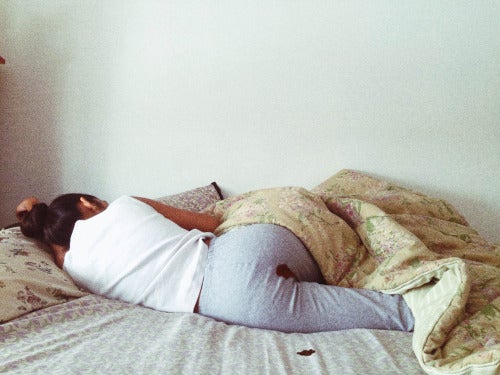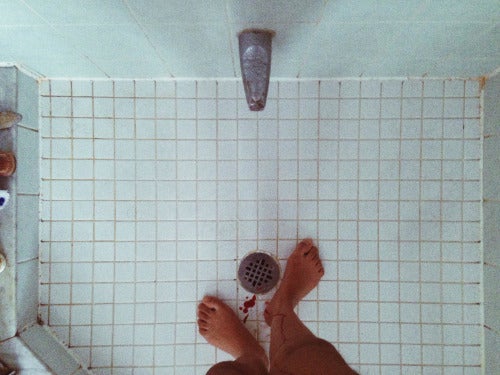Fourth-year English student Rupi Kaur experienced a very public finale to her undergraduate studies when a project for her Visual Rhetoric course unleashed a media storm. The assignment for ENGL 392B challenged students to engage a critical discussion using non-verbal media.
She created a series of six photos entitled Period. showing common but usually hidden scenes of a woman during her period.
In this assignment Rupi saw the perfect opportunity to execute a creative idea she’d had in her mind for a while. “When Beth Coleman, the wonderful professor for the course told us about the assignment, " says Rupi, "I knew the idea was striking and powerful enough to meet the assignment criteria effectively."
The lead photo shows a fully clothed woman in bed, back to camera, with a blood stain showing on her sweatpants and bed sheet. The images are muted yet powerful, making verbal description almost unnecessary

Rupi is a poet and visual artist as well as soon-to-graduate student. “I recognized that I wasn't creating something so people could like it,” she says. “I was creating something to start a conversation and a conversation was exactly what’s starting.”
She first posted the photos on her own website, then to her Instagram page. Within 24 hours the photos were taken down by Instagram. She immediately reposted, but the platform deleted them again, this time sending her a short note referencing their terms of use which state “violent, nude, partially nude, discriminatory, unlawful, infringing, hateful, pornographic, or sexually suggestive” images are prohibited.
And this is where the media storm began.
Rupi wanted to tackle the social taboo around public discussion of a woman’s period. She also wanted to provide “a peek in the day-to-day life of what happens to me and millions of others every single month,” she told The Star, one of several major media outlets to cover the story.


When Instagram’s censorship protocol issued a pat explanation about violating their content guidelines, Rupi wrote back:
thank you Instagram for providing me with the exact response my work was created to critique […] i will not apologize for not feeding the ego and pride of misogynist society […] when your pages are filled with countless photos/accounts where women (so many who are underage) are objectified. pornified. and treated less than human. thank you. […]”⠀⠀
After sending her 372-word statement to Instagram, she posted it to Facebook and Tumblr, tagging Instagram in each location and encouraging comments to also tag the platform. Over the next few days Rupi weathered an avalanche of comments, the majority highly supportive, some abusive and even threatening. About three million views and up to 11,000 comments later, a conversation had most definitely begun.
Instagram quickly restored the images, sending Rupi a short apology for the “accidental” deletion.
The Period. project has brought about change in a number of ways. “I think it's definitely worth the fight to expose double standards,” says Rupi. “After this ordeal and all the backlash they've received, Instagram has gone on to change their community guidelines to allow photos of women breastfeeding or showing mastectomy scars. […] But by fighting, the people are forcing Instagram to change, no matter how slowly that may be.”
In her project proposal, Rupi wrote:
“I see the way many communities avoid the menstruating women. In some societies a woman is not allowed out of her home on her period even to go to school, or she isn’t allowed to visit her religious place of worship because she’s considered dirty. […] By highlighting these distinct moments of the cycle that women go through I will be forcing viewers to look and tackle their fears head on.”
“The project was conceived as a critical inquiry on what our culture can show and cannot," English professor Beth Coleman commented. "When the images were censored, Rupi made an eloquent case on the visual rhetoric of soft porn on the internet, which goes without comment or censorship.”
The learning experience in the Visual Rhetoric course helped too. “All that I learned in the course allowed me to mark each step of this journey,” says Rupi. “I think it gave me the confidence I needed to stand by my work - from dealing with the critics and the supporters. It gave me a very grounded perspective on everything that was happening and I was able to keep my head up.”
Already with a strong social media presence before her Period. project went viral in late March, Rupi’s Instagram following increased from about 35,000 to 189,000 since then. Here she comments on the conundrum of using social media:
Is it worth the fight? For me it is. Because I use Instagram for work purposes. That is where I share my work as an artist, promote my book, and much more. It's helped me establish myself as a writer so getting rid of my account and leaving Instagram would be damaging to my art. I am spreading a message of social change, and it's ironic that I'm doing that through a platform which is problematic. But so many things these days are. Our institutions, our cities, the list goes on. We have to make the change. If we let it go then no change will happen. I think it's about creating a fine balance between how much we use social media and for what purposes.”
Just about to graduate and then spend the summer promoting her new book of poetry Milk and Honey, Rupi reflects on how the Rhetoric and Professional Writing program has enhanced her creative work:
It's allowed me to expand my horizons. It's given me the tools I need to think through multiple perspectives at once, which is something you need to be doing as a writer. Anytime I write a poem I look at it from many lenses. I want to create work that is universal so I have to ask myself: Is this work inclusive? Is it offensive to any minority group? What does this work mean in a larger global context? So on and so forth. My major has allowed me to answer these questions effectively, which has helped advance my artistic endeavours. It's also given me the chance to learn videography and graphic design, which I use in my art daily.”
Media covering Rupi’s project include:
- The Washington Post
- The Star
- The Telegraph
- The Huffington Post
- The Imprint